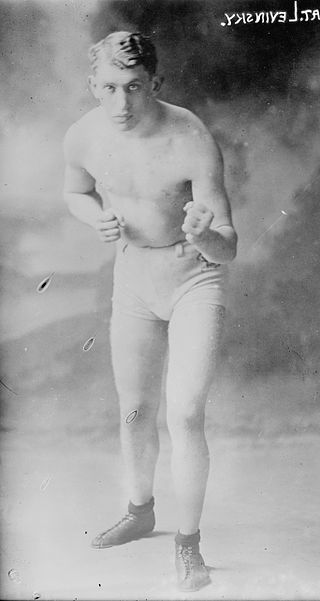Boj s Levinským získává první titul
Nikdo nevyužil éru profesionálního boxu bez rozhodnutí jako Battling Levinsky. Levinsky byl zkušený defenzivní boxer, který během svých bojů utrpěl malé poškození. Kdy Prstencový časopis zeptal se ho, proč je tak aktivní, někdy brát 3 bojuje za den kolem New Yorku, řekl Levinský, “Mám rád peníze a nikdy se nezraním.”
Levinsky se narodil jako Barney Lebowitz v červnu 10, 1891 in Philadelphia, Pennsylvania. Vybral název prstenu “Boj s Levinským” aby skryl svou profesi před rodiči, kteří mu boxování neschvalovali.

Fotka Barneyho Lebrowitze aka Battling Levinsky (Public Domain)
Levinsky si udržel zaměstnání během rané fáze své kariéry. Boxoval jen večer a o víkendech, dokud nevyhrál mistrovství světa. At that point, zpravodajství v novinách mu znemožnilo skrývat svou profesionální boxerskou kariéru před rodiči.
Levinský bojoval o a 170 bojuje v prvních šesti letech své kariéry. Ve svém 174. boji, Levinsky bojoval s Jackem Dillonem o verzi šampionátu v polotěžké váze v říjnu 24, 1916. Zápas se odehrál ve zbrojnici v Bostonu, Massachusetts.
Dillon byl mírným sázkařským favoritem, protože byl tvrdší úderník, zatímco Levinsky byl považován za mistra boxera. The bout was scheduled for 12 kola, standardní pro dnešek, ale mnohem kratší než normální 20-kolový zápas té doby. Kdyby ani jeden muž nedokázal toho druhého zastavit, o vítězi rozhodne rozhodčí.
Both men weighed 182 liber, ale Levinsky byl vyšší. Levinsky měl také znatelnou výhodu dosahu.
Rozhodčí Larry Conly přivedl muže do středového kruhu k obvyklému podání ruky. Poté dal znamení k zahájení zápasu.
In the first round, muži stanovili své strategie boje. Dillon se spoléhal na útok na tělo, aby zasadil údery do hlavy, z nichž většina minul Levinského. Levinsky použil bodnutí do obličeje, aby nastavil svůj útok. Levinsky skóroval znovu a znovu kombinací levého úderu a levého háku.
Zatímco Dillon minul většinou střel do hlavy, Zdálo se, že útok na tělo Levinského ve třetím kole unavil. Levinsky dostal druhý dech ve čtvrtém kole a pracoval také přes Dillonovo tělo.
Páté kolo nabídlo nejvíce akce. Levinsky nepřetržitě udeřil Dillona levou rukou do obličeje a těla. Dillon konečně vstřelil několik úderů do hlavy, aby se přidal k jeho tělesnému útoku. Oba muži udeřili volně a fanoušci se pořádně pustili do akce.
Zatímco fanoušci očekávali napínavou bitvu, šesté kolo znamenalo změnu v boji. Zatímco Dillon pokračoval v úderech do těla, zdálo se, že si poškodil ruce. Dillon neútočil tak volně a byl také viditelně unavený. Šok způsobený zraněním ruky mohl být také zodpovědný za Dillonův menší útok.
Levinsky pokračoval v používání levého úderu a levého háku s velkým efektem. Od sedmého kola dál, byl to jednostranný boj ve prospěch Levinského. Když rozhodčí po dvanáctém kole zvedl Levinského ruku na znamení jeho vítězství, ze strany fanoušků ani Dillona nebyly žádné stížnosti. Levinský zápas a titul jednoznačně vyhrál.
Levinský alespoň bojoval 289 bojuje ve svém 20 roční kariéry. Ve svém posledním boji u 40 let, Levinsky ve třetím kole zapsal svému soupeři technický knokaut. Na rozdíl od spousty bojovníků, který zůstal příliš dlouho, Levinsky vyšel z vítězství. V Prstencový časopis hlasování, byl hodnocen jako 9. nejlepší polotěžká váha všech dob.
You can leave a comment or ask a question about this or any post on my Facebook page.
Sources: Ring: Box ve 20. století od Stanleyho Westona (1993) a Boston Globe, Říjen 25, 1916 edition, p. 7

